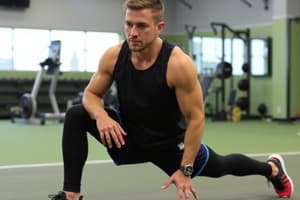Podcast
Questions and Answers
Which of the following is the MOST important consideration when determining exercise order?
Which of the following is the MOST important consideration when determining exercise order?
- Training status
- Athlete's preference
- Available equipment
- Exercise type (correct)
Which type of exercise involves one or more large muscle areas and two or more primary joints?
Which type of exercise involves one or more large muscle areas and two or more primary joints?
- Assistance exercise
- Power exercise
- Core exercise (correct)
- Structural exercise
Which of the following exercise arrangements is BEST for maximizing power output?
Which of the following exercise arrangements is BEST for maximizing power output?
- Plyometrics, squat, arm curl (correct)
- Power clean, bench press, bicep curl
- Bench press, power clean, triceps extension
- Squat, push jerk, lat pulldown
Alternating upper body exercises with lower body exercises allows for what?
Alternating upper body exercises with lower body exercises allows for what?
Which of the following is a characteristic of assistance exercises?
Which of the following is a characteristic of assistance exercises?
What is the primary emphasis of structural exercises?
What is the primary emphasis of structural exercises?
What is the PRIMARY benefit of alternating 'push' and 'pull' exercises in a resistance training program?
What is the PRIMARY benefit of alternating 'push' and 'pull' exercises in a resistance training program?
Which of the following best describes power exercises?
Which of the following best describes power exercises?
In the context of exercise order, what is a 'core' exercise?
In the context of exercise order, what is a 'core' exercise?
Which of the following BEST describes a superset?
Which of the following BEST describes a superset?
What principle states that the more similar the training activity is to the actual sport movement, the greater the likelihood that there will be a positive transfer to that sport?
What principle states that the more similar the training activity is to the actual sport movement, the greater the likelihood that there will be a positive transfer to that sport?
Which of the following is the definition of an agonist?
Which of the following is the definition of an agonist?
Which of the following BEST exemplifies a compound set?
Which of the following BEST exemplifies a compound set?
What does muscle balance refer to?
What does muscle balance refer to?
In a traditional resistance training program, after completing power exercises, which type of exercises should be performed next?
In a traditional resistance training program, after completing power exercises, which type of exercises should be performed next?
When should an athlete demonstrate an exercise technique?
When should an athlete demonstrate an exercise technique?
What adjustment might be necessary if specific resistance training equipment is unavailable?
What adjustment might be necessary if specific resistance training equipment is unavailable?
When training time per session is limited, which strategy is most effective?
When training time per session is limited, which strategy is most effective?
How does training status primarily affect resistance training program design?
How does training status primarily affect resistance training program design?
What is the general guideline for scheduling resistance training sessions targeting the same muscle groups?
What is the general guideline for scheduling resistance training sessions targeting the same muscle groups?
How can intermediate or advanced athletes augment their resistance training?
How can intermediate or advanced athletes augment their resistance training?
How does the sport season influence resistance training program design?
How does the sport season influence resistance training program design?
What adjustment should athletes make when training with maximal or near-maximal loads?
What adjustment should athletes make when training with maximal or near-maximal loads?
What strategy do advanced athletes use to stimulate strength gains while allowing proper recovery?
What strategy do advanced athletes use to stimulate strength gains while allowing proper recovery?
Flashcards
Core Exercises
Core Exercises
Exercises that recruit large muscle areas and involve multiple joints.
Assistance Exercises
Assistance Exercises
Exercises that recruit smaller muscle areas and involve a single joint.
Structural Exercises
Structural Exercises
Exercises that load the spine directly or indirectly.
Power Exercises
Power Exercises
Signup and view all the flashcards
Training Specificity
Training Specificity
Signup and view all the flashcards
Muscle Balance
Muscle Balance
Signup and view all the flashcards
Agonist Muscle
Agonist Muscle
Signup and view all the flashcards
Exercise Technique Experience
Exercise Technique Experience
Signup and view all the flashcards
Resistance Training Equipment
Resistance Training Equipment
Signup and view all the flashcards
Time-efficient Exercises
Time-efficient Exercises
Signup and view all the flashcards
Training Frequency
Training Frequency
Signup and view all the flashcards
Rest Days
Rest Days
Signup and view all the flashcards
Training Status
Training Status
Signup and view all the flashcards
Split Routine
Split Routine
Signup and view all the flashcards
Maximal Training Loads
Maximal Training Loads
Signup and view all the flashcards
Physical Stress
Physical Stress
Signup and view all the flashcards
Exercise Order
Exercise Order
Signup and view all the flashcards
Alternating Upper/Lower Body
Alternating Upper/Lower Body
Signup and view all the flashcards
Push and Pull Exercises
Push and Pull Exercises
Signup and view all the flashcards
Supersets
Supersets
Signup and view all the flashcards
Compound Sets
Compound Sets
Signup and view all the flashcards
Study Notes
Program Design: Exercises
- Program design focuses on exercise selection, type, order, and frequency for training.
- Exercise selection considers various factors, including exercise type, technique experience, equipment availability, and training time.
Exercise Selection
- Exercise Type: Includes core and assistance exercises, structural and power exercises, movement analysis of the sport, and sport-specific exercises.
- Exercise Technique Experience: Assess athlete's ability to perform exercises correctly, provide demonstrations and instructions as needed.
- Availability of Resistance Training Equipment: Adjust exercises if equipment is limited.
- Available Training Time per Session: Prioritize time-efficient exercises.
Exercise Type
- Core and Assistance Exercises: Core exercises target multiple joints and are important for sport; assistance exercises focus on single joints and often support or complement core exercises.
- Structural and Power Exercises: Structural exercises load the spine directly or indirectly; power exercises are structural exercises performed quickly or explosively.
- Movement Analysis of the Sport: Exercises should mirror the movement patterns of the sport for optimal positive transfer
Sport-Specific Exercises
- Movement Specificity: Closely matching training activity to actual sport movement leads to better performance transfer—this concept is known as training specificity or specific adaptation to imposed demands (SAID principle).
- Exercise Examples: Jumping specificity: power clean > back squat > leg press > plyometrics (examples)
- Consider the plane of movement, muscles, and movement speed during exercise selection.
Muscle Balance
- Balance: Ensuring muscular strength across joints and between opposing groups (agonist and antagonist muscles).
- Ratio: Muscle balance isn't always equal strength; rather, it focuses on a proper ratio of strength, power, or muscular endurance between opposing muscle groups (e.g., knee flexor/extensor).
Step 2: Exercise Selection
- Exercise Technique Experience: Do not assume athletes perform exercises correctly; have them demonstrate and provide instruction as needed.
Step 3: Training Frequency
- Training Status: Training status (novice, moderate, extensive experience) impacts the number of rest days needed between sessions.
- Sport Season: Seasonal demands may restrict training time. Training frequency guidelines differ based on sport season (e.g., off-season, in-season).
- Training Load and Exercise Type: High-intensity training requires more recovery time prior to the next training session; alternate "heavy" and "light" days. Multi-joint exercises are particularly important to consider in this context
- Other Training: Overall physical stress impacts training frequency; consider aerobic/anaerobic training and physically demanding occupations.
Step 4: Exercise Order
- Power, Other Core, Then Assistance Exercises: Prioritize power exercises (e.g., power clean, push jerk), followed by core (e.g., bench press, squat), and then assistance exercises (e.g., arm curl, knee extension).
- Upper and Lower Body Exercises: Alternate upper and lower body exercises for improved recovery between exercises. This method is often referred to as circuit training when rest times are minimal
- "Push" and "Pull" Exercises: Alternate between pushing and pulling exercises (e.g., bench press with lat pulldowns) to improve recovery and recruitment between exercise types.
- Supersets and Compound Sets: A superset involves consecutive exercises targeting opposing muscle groups; a compound set involves consecutive exercises targeting the same muscle group.
Studying That Suits You
Use AI to generate personalized quizzes and flashcards to suit your learning preferences.




